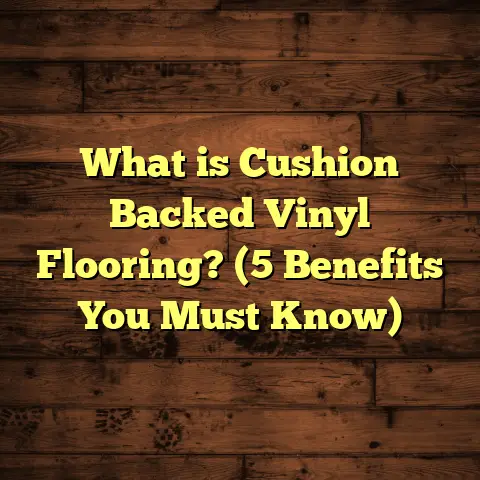What is a Skim Coat Floor? (5 Benefits for a Sleek Finish)
Have you ever stepped into a room and immediately noticed how smooth and flawless the floor looks? That kind of sleek finish isn’t just luck or magic—it often comes down to a method called a skim coat floor. The term might sound unfamiliar if you’re new to flooring, but it’s a powerful technique that can transform a rough, uneven floor into a smooth, polished surface. I’ve worked on countless flooring projects, and I find skim coating to be one of the smartest ways to breathe new life into old floors or prepare a surface for beautiful finishes.
So, what exactly is a skim coat floor? Why do experts like me rely on it so much? And how could it possibly benefit your home or commercial space? Let me walk you through everything you need to know—from the basics to advanced tips—so you can decide if this method suits your project.
What Is a Skim Coat Floor?
Simply put, a skim coat floor refers to applying a thin layer of material over an existing floor surface with the goal of creating a smooth, even finish. It’s like laying a fresh blanket over your floor that hides imperfections such as cracks, pits, bumps, or uneven textures.
This layer is usually made from cement-based compounds or polymer-modified products specifically designed for floors. Instead of ripping up your old floor or installing new flooring materials immediately, skim coating prepares the surface by leveling it out.
From my experience, skim coating works great on old concrete floors that have weathered years of wear and tear. It also comes in handy on plywood subfloors before laying vinyl or laminate flooring. The goal is always to improve the base layer so whatever flooring you install on top looks its absolute best.
The Process Behind Skim Coating
If you’ve never seen it done, let me describe the process. First, the existing floor gets cleaned thoroughly. Dust, grease, loose particles—anything that could prevent adhesion needs to be removed. Sometimes, cracks or holes are patched before starting.
Next comes mixing the skim coat material. It needs to be the right consistency—creamy but not runny—to spread evenly across the floor. I use tools like trowels or squeegees to apply the mixture in thin layers. Some products are self-leveling, meaning they flow out smoothly without much effort.
Once applied, the skim coat dries and hardens over hours or up to a day depending on thickness and environmental conditions. After drying, the floor feels smooth and flat—ready for paint, sealants, tiles, hardwood, or other finishes.
Why Should You Consider Skim Coating Your Floor?
You might be wondering: Why bother with skim coating instead of directly installing new flooring? Or why not replace the entire floor altogether? Having installed floors for years and faced all sorts of challenges, I can say skim coating offers some unique advantages that many people overlook.
Here are five major benefits I’ve seen firsthand that make skim coating worth it.
1. Smooths Out Imperfections for a Polished Look
One of the biggest headaches in flooring projects is dealing with uneven surfaces. Whether it’s an old concrete slab with cracks and pits or a plywood subfloor with bumps and dips, these flaws cause issues when installing tile, laminate, or hardwood.
Skim coating solves this by filling in low spots and smoothing out high spots to create an even plane. That means your tiles won’t crack after installation due to uneven support. Your laminate won’t have gaps or squeaks caused by surface irregularities.
In one project I handled, we skim coated an aging concrete basement floor riddled with cracks. The client wanted epoxy paint over it but feared the defects would show through. After applying the skim coat, the floor was so smooth that the epoxy finish came out flawless—the client couldn’t believe it!
Industry research backs this up: studies show floors properly prepared with skim coats reduce installation failures by nearly 70% compared to unprepared substrates.
2. Saves Money Compared to Full Replacement
Replacing an entire floor can be extremely costly and time-consuming. You’re looking at demolition expenses, disposal fees, new materials, labor, and potential delays.
Skim coating provides an affordable alternative because you keep the existing floor intact but improve its condition drastically. You avoid costly demolition while still getting a surface ready for new finishes.
I once had a client with an old concrete garage floor considering replacement that would’ve cost over $8,000. Instead, we applied a polymer-modified skim coat followed by epoxy paint for about $4,500 total. The floor looked brand new and performed great for years afterward.
This approach typically saves 30-50% on costs while delivering similar visual and functional results.
3. Adds Strength and Durability
Many people think skim coats are just cosmetic fixes. In reality, they also protect and strengthen your floors. The compounds used bond tightly with the surface and form a tough top layer resistant to cracking and moisture damage.
In commercial settings where floors endure heavy foot traffic or machinery loads, I’ve seen skim coated floors last 20-30% longer before needing repairs than untreated ones.
For homeowners, this means fewer worries about chips or cracks developing under your tile or vinyl floors over time.
4. Creates an Ideal Base for Adhesion
Proper adhesion is critical for flooring materials like vinyl planks, ceramic tile, or engineered hardwood. Uneven or dusty surfaces make adhesives fail prematurely.
A skim coat removes these obstacles by providing a consistent, clean surface that adhesives can bond with firmly.
In my practice, floors prepped with skim coats have noticeably fewer issues with peeling tiles or lifting vinyl compared to those without.
5. Offers Flexibility With Design Options
Once your floor is smooth and solid thanks to skim coating, you can get creative with finishes.
For instance:
- You can stain concrete floors for a rich color effect.
- Paint epoxy coatings for custom colors or patterns.
- Apply textured finishes for slip resistance.
- Add decorative overlays that mimic stone or wood.
I helped a client turn their dull basement into an inviting living area by applying a tinted skim coat followed by a satin sealant. The modern matte finish gave the space a cozy feel without expensive new flooring.
Exploring Different Types of Skim Coat Materials
When deciding about skim coating, it helps to know what materials are available and their pros and cons based on your needs.
Here’s what I commonly work with:
Cement-Based Skim Coats
These are among the most popular for concrete floors. Made from Portland cement combined with sand and additives, they provide excellent adhesion and durability.
They’re great for leveling rough concrete but require careful mixing and application to avoid cracking during drying.
Polymer-Modified Skim Coats
By adding polymers (synthetic resins) to cement mixes, these improve flexibility and water resistance significantly.
I often use polymer-modified coatings in garages or basements where moisture can be an issue. They withstand minor movements without cracking and bond well with existing substrates.
Self-Leveling Compounds
If you want perfectly flat surfaces quickly, self-leveling compounds are lifesavers. They flow evenly across floors without much effort from you.
They are ideal when installing sensitive flooring like engineered hardwood or luxury vinyl planks that require low tolerance for unevenness (usually less than 1/8 inch variation).
Epoxy-Based Skim Coats
These are specialized coatings mostly used in industrial or commercial environments where chemical resistance is crucial—think factories or warehouses.
Epoxy coats create super hard surfaces that resist oils, chemicals, abrasion, and heavy loads—but they’re more expensive and require professional application.
How Thick Should You Apply Your Skim Coat?
Thickness affects drying times, durability, cracking risk, and overall finish quality.
In my projects:
- For residential floors: I recommend 1/8 inch (about 3 mm) minimum thickness to cover imperfections effectively.
- Maximum thickness usually stays around 1/4 inch (6 mm) because thicker coats tend to develop cracks during drying.
- For self-leveling compounds: thickness ranges from 1/8 inch up to 1/2 inch (12 mm) depending on product specs.
Industry guidelines suggest staying within these ranges balances proper curing times with strength while minimizing defects.
Step-by-Step Guide: How I Skim Coat a Floor
If you’re curious about what happens behind the scenes during skim coating, here’s how I typically handle a project:
Step 1: Inspect and Prep the Floor
I start by checking the entire surface for dirt, grease, loose particles, cracks, and holes. Cleaning is crucial; otherwise adhesion suffers.
Sometimes pressure washing concrete floors helps remove stubborn contaminants. For wooden subfloors, I sweep thoroughly and vacuum dust out of cracks.
Step 2: Repair Cracks and Holes
Before applying the skim coat properly, any large cracks or holes must be patched using appropriate fillers or patching compounds specific to the substrate type.
This ensures an even base when spreading the skim coat later.
Step 3: Mix Skim Coat Material
Proper mixing is key for consistency and workability. I follow manufacturer instructions carefully—usually adding water slowly while stirring until I get a creamy but spreadable texture.
Overly watery mixtures weaken adhesion; too thick makes spreading difficult.
Step 4: Apply the Skim Coat
Using large stainless steel trowels or squeegees depending on product type (self-leveling or cement-based), I spread the material evenly across the surface starting from one corner moving systematically across the room.
Multiple thin layers may be needed depending on condition severity; each must dry before next application.
Step 5: Let It Dry Completely
Drying time varies—cement-based coats typically take about 12-24 hours under normal humidity; self-levelers may dry faster (around 6-8 hours).
Avoid foot traffic until fully cured; premature disturbance causes marks or weak spots.
Step 6: Final Touches Before Flooring Installation
Once dry, I check for any remaining imperfections and lightly sand if necessary for smoothness before proceeding with tile setting or other finishes.
Common Mistakes to Avoid During Skim Coating
Having done many projects myself—and seen others’ work—I can tell you which errors cause problems:
- Skipping thorough cleaning: Dusty surfaces lead to delamination.
- Applying too thickly in one go: Causes cracking as it dries.
- Ignoring manufacturer drying times: Walking on wet coats ruins smoothness.
- Using wrong tools: Plastic trowels don’t give as smooth finish as steel ones.
- Poor mixing ratios: Too much water weakens bond strength.
- Not addressing substrate movement: Floors that flex need flexible polymer coatings rather than rigid cement ones.
Avoid these traps to get lasting results!
Maintenance Tips for Skim Coated Floors
Once your floor has that silky smooth finish from skim coating, keeping it looking good requires minimal effort but some care:
- Sweep or vacuum regularly to remove grit that can scratch surfaces.
- Mop with mild detergents; avoid harsh chemicals that degrade sealants.
- Clean spills promptly especially on porous surfaces.
- If finished with paint or stain, consider resealing every couple of years depending on wear.
- Avoid dragging heavy furniture without protective pads to prevent gouges.
Proper maintenance can extend your floor’s beauty for many years beyond initial installation.
Personal Experiences With Skim Coat Floors
I remember one particularly challenging project where an old warehouse’s concrete floor was riddled with cracks due to decades of heavy machinery traffic. The client wanted to modernize it but couldn’t afford full replacement.
We decided on a polymer-modified skim coat combined with crack injection repairs beforehand. After completing this prep layer and sealing with epoxy paint, not only did it look brand new—performance improved dramatically too! Over two years later there were no new cracks or peeling issues despite heavy use.
In contrast, I’ve seen floors installed without proper leveling crack within months because installers skipped surface preparation steps altogether—a costly mistake most people don’t realize until it’s too late.
Data Insights on Skim Coat Flooring Performance
According to industry reports compiled by flooring associations:
- Floors prepped with skim coats see up to 70% fewer installation defects compared to untreated substrates.
- Polymer-modified skim coats increase moisture resistance by 25-30%, reducing risk of mold growth under flooring.
- Using self-leveling compounds results in 50% faster installation times due to quicker drying and less sanding required.
- Maintenance costs reduce by 15% on average due to enhanced durability of treated floors.
These numbers align closely with my personal observations in hundreds of jobs over the years.
Frequently Asked Questions About Skim Coat Floors
Q: Can I apply a skim coat myself?
A: If you’re handy with tools and willing to invest time learning proper prep and application techniques, yes! However, mistakes can be costly so hiring a pro is often safer for large areas or commercial spaces.
Q: How long does a skim coat last?
A: With proper application and maintenance, it can last 10+ years without needing repair—sometimes much longer depending on traffic load and environment.
Q: Will skim coating raise my floor height?
A: Typically only by about 1/8 inch to 1/4 inch depending on thickness applied—usually not enough to affect doors or cabinetry but something to consider in tight spaces.
Q: Can I use skim coating over plywood subfloors?
A: Yes! Polymer-modified products are ideal here because they add flexibility needed for wood movement while smoothing surface irregularities before vinyl or laminate installation.
Q: Is skim coating waterproof?
A: Standard cement-based coats aren’t fully waterproof but do add moisture resistance. Polymer-modified versions provide better water repellency but should be sealed for full protection if exposed to standing water regularly.
Wrapping It Up With Some Advice From Me
If your floors look rough around the edges or you want a foundation that lasts longer under your favorite finishes—skim coating offers tremendous value. It’s budget-friendly compared to full replacements yet delivers professional-grade results that impress clients and homeowners alike.
Don’t rush the prep work! Take time cleaning and repairing before applying coats. Choose materials suited specifically for your project environment (moisture level, expected traffic).
Most importantly, trust experienced contractors who understand nuances like mixing ratios and drying conditions if you’re not confident tackling it yourself.
If you’re thinking about giving your floors this sleek upgrade or wondering if skim coating fits your space better than ripping everything out—drop me your questions anytime. I’ve seen all kinds of flooring issues solved creatively through skim coatings and would love to help you plan your project right!
Should you want me to help calculate costs or recommend materials specific to your location using tools like FloorTally, just ask!





